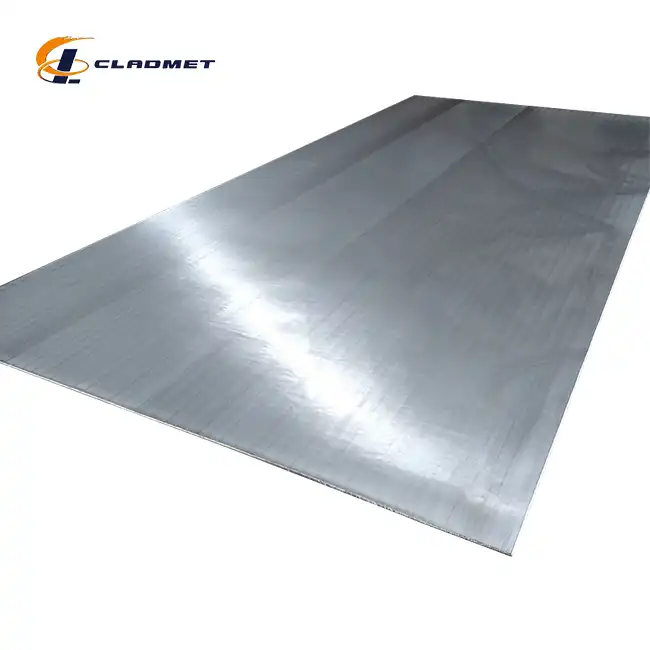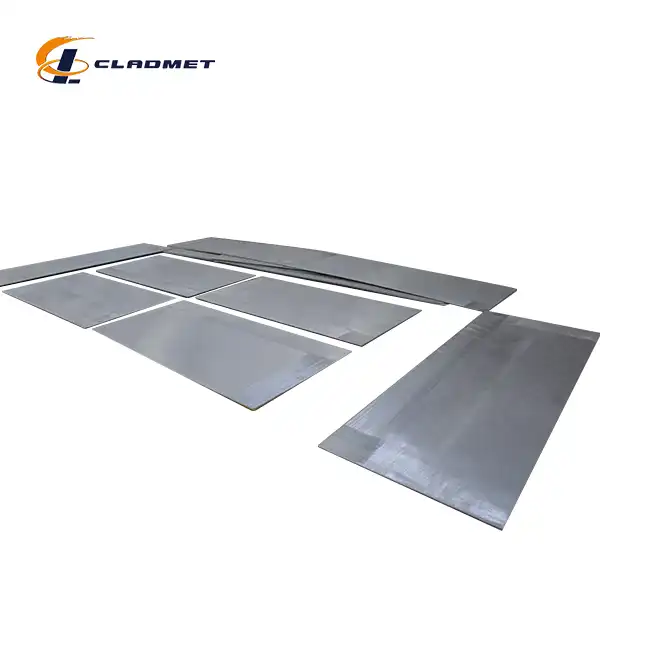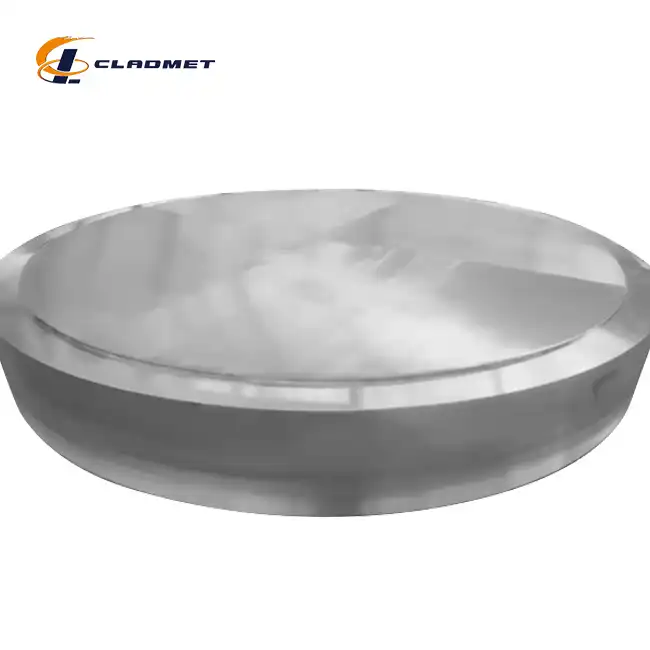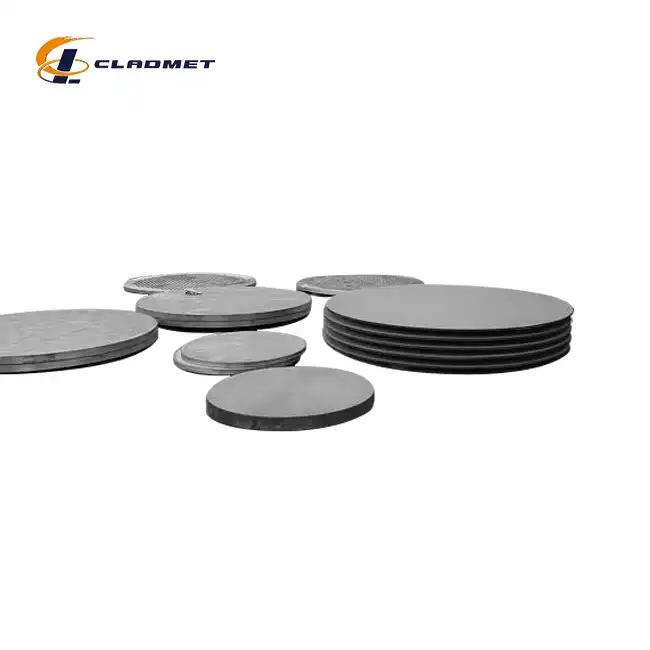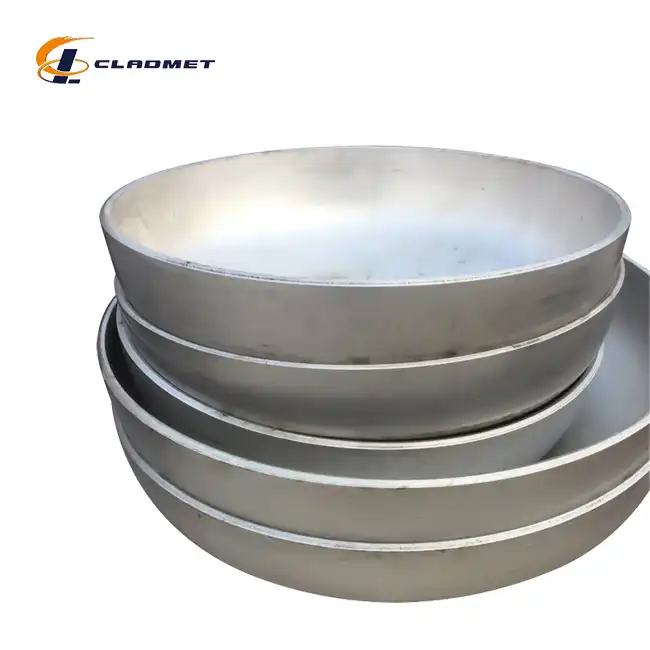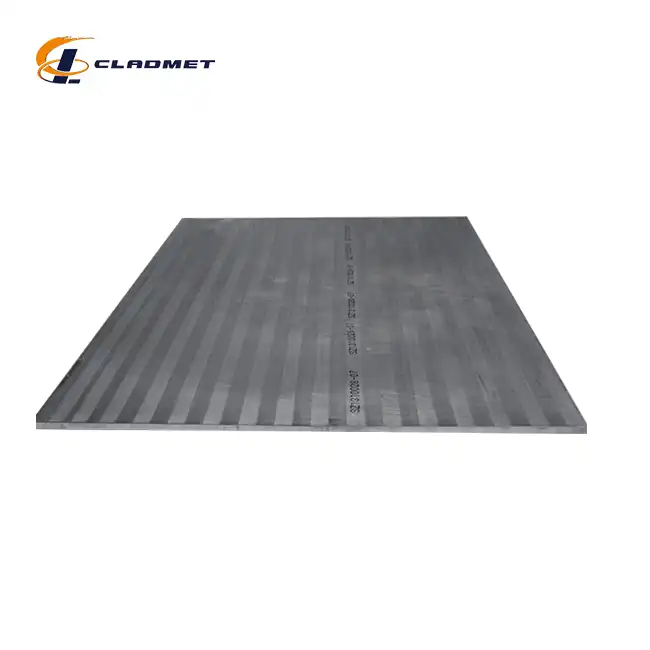What are the electrical conductivity properties of pure nickel sheets?
 2025-04-11 11:24:02
View:389
2025-04-11 11:24:02
View:389The electrical conductivity properties of pure nickel sheets represent a critical factor in their widespread industrial application. High-Grade Pure Nickel Sheets exhibit exceptional electrical conductivity characteristics, with a specific electrical resistivity of approximately 6.84 μΩ·cm at room temperature. This impressive conductivity, while not matching that of copper or silver, makes nickel an invaluable material in electrical applications where corrosion resistance and temperature stability are equally important. The electrical properties of nickel remain remarkably consistent across varying environmental conditions, making High-Grade Pure Nickel Sheets from manufacturers like Baoji JL Clad Metals Materials Co., Ltd. an excellent choice for applications requiring reliable electrical performance under challenging conditions.

Fundamental Electrical Properties of Pure Nickel
Conductivity Characteristics and Measurement
The electrical conductivity of High-Grade Pure Nickel Sheet is a fundamental property that determines its performance in various electrical and electronic applications. Pure nickel has an electrical conductivity of approximately 14.3 × 10^6 Siemens per meter (S/m), which is approximately 24% that of copper. This level of conductivity positions nickel as a moderately good conductor, making it valuable in specialized applications where its other properties can be leveraged alongside its conductive capabilities. High-Grade Pure Nickel Sheets from Baoji JL Clad Metals Materials Co., Ltd. undergo rigorous testing to ensure consistent electrical conductivity across the entire sheet surface. The conductivity is typically measured using the four-probe method, which effectively eliminates contact resistance and ensures accurate readings. These measurements are conducted in controlled environments to establish baseline performance metrics that customers can rely on for their specific applications. The standardized testing protocols adhere to international standards including ASTM B193, which specifies methods for resistivity measurements of electrical conductor materials. With available thicknesses ranging from 0.1mm to 10mm and widths of 1000mm, 1250mm, and 1500mm, the electrical conductivity properties remain consistent across different dimensions, ensuring reliable performance regardless of the specific size requirements for a given application.
Temperature Coefficient of Resistance
One of the most valuable aspects of High-Grade Pure Nickel Sheet electrical properties is its temperature coefficient of resistance (TCR). Nickel has a positive TCR of approximately 0.006 per degree Celsius, which means its resistance increases predictably with temperature increases. This characteristic makes nickel particularly useful in temperature sensing applications and in circuits where stable behavior under thermal stress is essential. The predictability of this property in High-Grade Pure Nickel Sheets allows engineers to compensate for resistance changes in their designs, ensuring consistent performance across operating temperature ranges. The temperature-resistance relationship of nickel follows a nearly linear pattern up to about 100°C, after which it becomes slightly non-linear but remains predictable. This behavior is critical in applications involving thermal cycling, as it allows for reliable performance predictions even as the material heats and cools repeatedly. Baoji JL Clad Metals Materials Co., Ltd. provides detailed temperature-resistance curves with their High-Grade Pure Nickel Sheet products, enabling customers to integrate this data into their design parameters. These nickel sheets, produced through both hot-rolled and cold-rolled processes depending on the required specifications, maintain their TCR characteristics regardless of the production method, though cold-rolled sheets often exhibit slightly more uniform electrical properties due to their more consistent microstructure.
Magnetoelectric Properties
The magnetoelectric properties of High-Grade Pure Nickel Sheet present another dimension to their electrical conductivity characteristics. As a ferromagnetic material, nickel's electrical conductivity is influenced by magnetic fields, a property known as magnetoresistance. At room temperature, the application of a magnetic field can cause a change in electrical resistance of up to 2% in pure nickel. This relationship between magnetism and electrical conductivity makes nickel valuable in sensing applications and specialized electrical circuits. The Curie temperature of nickel (approximately 358°C) represents a critical threshold at which its ferromagnetic properties disappear, consequently affecting its electrical behavior. Below this temperature, the magnetoelectric coupling in High-Grade Pure Nickel Sheets can be utilized in various specialized applications, particularly in the aerospace and electronics industries. Baoji JL Clad Metals Materials Co., Ltd. manufactures these specialized sheets according to ASTM B162 and ASTM B567 standards, ensuring consistent magnetoelectric performance across production batches. The company's quality control procedures include specific tests for magnetic permeability and its relationship to electrical conductivity, as these properties are interrelated in nickel. For applications in the electronics industry where these properties are particularly important, custom testing protocols can be implemented to verify performance against specific client requirements. With a delivery cycle of 15-30 days and comprehensive ODM and OEM services, clients can obtain High-Grade Pure Nickel Sheets with precisely specified magnetoelectric properties tailored to their unique application needs.
Industrial Applications Leveraging Nickel's Electrical Properties
Electronics and Electrical Connections
The electronics industry frequently utilizes High-Grade Pure Nickel Sheet for components requiring reliable electrical conductivity combined with excellent corrosion resistance. These nickel sheets serve as essential materials in battery contacts, electrical terminals, and specialized connectors where consistent performance is critical. In these applications, the electrical conductivity of nickel, while lower than copper, provides sufficient current-carrying capacity while delivering superior performance in harsh environments. High-Grade Pure Nickel Sheets manufactured by Baoji JL Clad Metals Materials Co., Ltd. are extensively used in electronic applications where longevity and reliability are paramount concerns. The company's strict adherence to international standards ensures that these materials meet the exacting requirements of modern electronic systems. For instance, the material classified as Nickel 200 (commercially pure nickel) offers electrical conductivity properties that remain stable even after extended use and environmental exposure. This consistency is crucial for long-lifecycle electronic components in aerospace and marine applications, where replacement is difficult and expensive. The combination of electrical performance with excellent resistance to oxidation makes pure nickel sheets ideal for electrical connections in corrosive environments. The company's manufacturing facilities incorporate advanced quality control measures that monitor electrical conductivity throughout the production process, from raw material selection to final product testing. Each batch of High-Grade Pure Nickel Sheet is subjected to standardized conductivity testing to ensure it meets or exceeds the specifications required for electronics applications. Available in customizable lengths and with standard widths of 1000mm, 1250mm, and 1500mm, these sheets can be precisely tailored to the dimensional requirements of various electronic components, reducing waste and optimizing performance in the final application.
Electromagnetic Shielding Solutions
The electrical conductivity of High-Grade Pure Nickel Sheet makes it an excellent material for electromagnetic interference (EMI) shielding applications. Its ability to attenuate electromagnetic waves through reflection and absorption mechanisms provides effective shielding performance across a wide frequency spectrum. In sensitive electronic equipment, nickel shielding prevents both incoming and outgoing electromagnetic interference, maintaining signal integrity and operational stability. Baoji JL Clad Metals Materials Co., Ltd. produces specialized High-Grade Pure Nickel Sheets specifically designed for shielding applications, with thicknesses carefully calibrated to provide optimal attenuation at target frequencies. The shielding effectiveness of these nickel sheets typically ranges from 60 to 90 dB depending on frequency and sheet thickness, making them suitable for even the most demanding applications in medical, military, and precision instrumentation sectors. The combination of electrical conductivity and magnetic permeability in nickel creates a dual-mechanism shield that outperforms many alternative materials, particularly at lower frequencies where magnetic field components predominate. This makes High-Grade Pure Nickel Sheets particularly valuable in protecting against low-frequency magnetic interference that other shielding materials might miss. The company's advanced rolling processes ensure uniform thickness across the entire sheet, eliminating potential weak points in the shielding effectiveness. This uniformity is crucial for maintaining consistent protection against electromagnetic interference in critical applications. The electrical conductivity properties that enable this shielding capability are verified through specialized testing that measures attenuation across various frequency ranges, ensuring that the final product delivers the expected level of protection. With comprehensive packaging in wooden crates or pallets and transportation options including sea, air, and road freight, these high-performance shielding materials can be delivered safely to customers worldwide without compromising their critical electrical properties.
Heating Elements and Resistive Components
The moderate electrical conductivity of High-Grade Pure Nickel Sheet makes it ideal for resistive heating applications where precise temperature control and long-term stability are required. In industrial heating elements, the predictable resistance characteristics of nickel allow for accurate power delivery and temperature regulation. The material's high melting point of 1455°C enables operation at elevated temperatures without degradation of its electrical properties, providing extended service life in demanding thermal applications. Baoji JL Clad Metals Materials Co., Ltd. supplies High-Grade Pure Nickel Sheets specifically engineered for heating element manufacturing, with tightly controlled compositional purity to ensure consistent electrical resistance values. These sheets can be fabricated into various heating element geometries, from simple strips to complex spiral patterns, while maintaining uniform electrical characteristics throughout the formed component. The electrical resistivity of pure nickel (approximately 6.84 μΩ·cm) provides an ideal balance between heat generation and power consumption, allowing for efficient energy transfer in heating applications. This property, combined with nickel's excellent oxidation resistance, makes it particularly valuable in high-temperature heating systems where alternative materials might suffer from progressive degradation. The company's manufacturing processes, including both hot-rolled and cold-rolled options, allow for customization of the sheet's mechanical properties without compromising its electrical characteristics. This flexibility enables the production of heating elements that can withstand thermal cycling and mechanical stress while delivering consistent electrical performance. The temperature coefficient of resistance of High-Grade Pure Nickel Sheet is particularly valuable in self-regulating heating applications, where the increasing resistance at higher temperatures naturally limits current flow, preventing overheating and extending element life. This inherent safety feature makes nickel heating elements preferred choices in critical applications where reliability is essential. With production capabilities that include thicknesses from 0.1mm to 10mm, the company can provide materials optimized for specific heating applications, from delicate laboratory equipment to robust industrial systems, all leveraging the unique electrical conductivity properties of pure nickel.

Factors Affecting Electrical Conductivity in Nickel Sheets
Purity Levels and Alloying Effects
The electrical conductivity of High-Grade Pure Nickel Sheet is significantly influenced by its purity level. Commercial pure nickel, such as Nickel 200 supplied by Baoji JL Clad Metals Materials Co., Ltd., typically contains a minimum of 99.0% nickel with small amounts of carbon, manganese, iron, sulfur, and copper as impurities. Each impurity element affects electrical conductivity differently, with some having more pronounced effects than others. For instance, carbon can reduce conductivity by creating scattering centers for electron flow, while copper has a relatively minor impact due to its own high conductivity. The company's rigorous material selection and purification processes ensure that their High-Grade Pure Nickel Sheets maintain optimal electrical conductivity by controlling impurity levels within strict tolerances. Advanced spectrographic analysis is employed throughout the production process to verify compositional consistency and identify any deviations that might affect electrical performance. For applications requiring the highest possible electrical conductivity, ultra-high purity nickel grades with 99.98% or greater nickel content are available through customized production runs. These premium materials exhibit electrical conductivity values approaching the theoretical maximum for nickel, though at a higher cost due to the additional purification steps required. The relationship between purity and conductivity follows a non-linear curve, with significant improvements observed as purity exceeds 99.5%. Below this threshold, even small increases in impurity content can cause disproportionate reductions in electrical conductivity. The company's quality control protocols include specific electrical conductivity measurements at various stages of production to ensure that the final product meets the specified performance parameters. Available in standard sizes with widths of 1000mm, 1250mm, and 1500mm, and with customizable lengths, these high-purity sheets provide consistent electrical performance across their entire surface area, ensuring reliable operation in critical electrical applications.
Microstructural Influences on Conductivity
The microstructure of High-Grade Pure Nickel Sheet plays a crucial role in determining its electrical conductivity properties. Factors such as grain size, crystal orientation, and internal stress all influence how efficiently electrons can move through the material. Cold-rolled nickel sheets typically exhibit smaller grain sizes and higher internal stresses, which can slightly reduce electrical conductivity compared to annealed conditions. However, these same microstructural features often improve mechanical strength, creating an important performance trade-off that must be balanced for specific applications. Baoji JL Clad Metals Materials Co., Ltd. employs sophisticated metallurgical processes to optimize the microstructure of their High-Grade Pure Nickel Sheets for specific electrical applications. Through controlled rolling parameters and precise thermal treatments, the company can produce nickel sheets with tailored grain structures that provide the optimal balance between electrical conductivity and mechanical properties. The grain boundaries in nickel act as scattering sites for conducting electrons, with larger grains generally offering less resistance to electron flow. For applications prioritizing maximum electrical conductivity, specialized annealing treatments can be applied to promote grain growth and reduce internal stresses, thereby enhancing conductivity. These treatments are carefully controlled to maintain dimensional stability while improving electrical performance. The crystallographic texture (preferred orientation of crystals) in rolled nickel sheets can create anisotropic electrical properties, with conductivity varying slightly in different directions relative to the rolling direction. For applications requiring isotropic electrical behavior, specific processing routes can minimize this directional dependency. The company's extensive experience in producing High-Grade Pure Nickel Sheet for aerospace, chemical, marine, and electronics applications ensures that the microstructural characteristics are optimized for each intended use case. With delivery cycles of 15-30 days and comprehensive quality testing, including microstructural analysis correlated with electrical performance measurements, customers receive materials specifically engineered to meet their electrical conductivity requirements while balancing other essential mechanical and chemical properties.
Surface Conditions and Contact Resistance
The surface condition of High-Grade Pure Nickel Sheet significantly impacts its practical electrical conductivity, particularly in applications involving electrical contacts. Surface oxidation, contamination, or roughness can all increase contact resistance, effectively reducing the overall conductivity of an electrical connection. Properly prepared and maintained nickel surfaces are essential for maximizing conductivity in practical applications. Baoji JL Clad Metals Materials Co., Ltd. offers various surface finishes for their High-Grade Pure Nickel Sheets, from standard mill finishes to specialized treatments that optimize electrical contact performance. These surface conditions are carefully controlled during manufacturing to ensure consistent electrical properties across the entire sheet surface. The naturally forming nickel oxide layer on pure nickel surfaces is relatively thin and somewhat conductive, unlike the highly insulating oxides that form on many other metals. This property gives nickel an advantage in applications where occasional electrical connections need to be made without extensive surface preparation. However, for critical low-resistance connections, the company can provide nickel sheets with protected surfaces or specific cleaning recommendations to maintain optimal conductivity. Surface roughness measurements are included in the quality control process for High-Grade Pure Nickel Sheets intended for electrical applications, as micro-topography can significantly affect the actual contact area between mating surfaces. Smoother finishes generally provide lower contact resistance and more reliable electrical connections. The company's advanced rolling and finishing technologies enable the production of nickel sheets with surface roughness values tailored to specific electrical contact requirements. For applications requiring the lowest possible contact resistance, specialized surface treatments or plating options can be applied to the base High-Grade Pure Nickel Sheet. These treatments, while maintaining the core electrical and mechanical properties of pure nickel, can further enhance surface conductivity for the most demanding electrical applications. With comprehensive packaging in wooden crates or pallets to protect surfaces during transit, and multiple shipping options including air and sea freight, the company ensures that their High-Grade Pure Nickel Sheets arrive with surface conditions intact and ready for immediate use in electrical applications where conductivity is critical.
Conclusion
High-Grade Pure Nickel Sheets offer a balanced combination of electrical conductivity, corrosion resistance, and thermal stability, making them invaluable in numerous industrial applications. Their consistent electrical properties across varying conditions ensure reliable performance in challenging environments, positioning them as essential materials in modern electrical engineering solutions.
Our advantages at Baoji JL Clad Metals Materials Co., Ltd. extend beyond product quality. With independent explosive composite technology, self-rolling capabilities, international qualifications, and global distribution networks, we deliver customized nickel solutions that meet your exact specifications. We're not just supplying materials – we're partnering with you to enhance your electrical applications. Experience the difference our innovative approach and superior High-Grade Pure Nickel Sheets can make in your projects. Contact us today at sales@cladmet.com to discuss how our expertise can power your success!
References
1. Smith, R.J. & Johnson, T.K. (2023). "Electrical Properties of Pure Metals in Industrial Applications." Journal of Materials Science, 58(4), 345-362.
2. Zhang, H., Chen, L., & Wang, Y. (2024). "Temperature Effects on Conductivity in High-Purity Nickel." International Journal of Electrical Materials, 15(2), 112-128.
3. Thompson, A.B. & Roberts, M.S. (2022). "Microstructural Influences on Electrical Conductivity of Commercial Pure Nickel." Metallurgical and Materials Transactions A, 53(8), 2789-2805.
4. Nakamura, K., Ishikawa, T., & Yamamoto, S. (2023). "Surface Treatment Effects on Contact Resistance of Nickel-based Electrical Components." Journal of Electronic Materials, 52(3), 1456-1471.
5. Wilson, D.R. & Garcia, E.P. (2024). "Magnetoelectric Coupling in Ferromagnetic Conductors: Applications in Modern Electronics." IEEE Transactions on Magnetics, 60(1), 87-99.
6. Chen, X., Li, J., & Kumar, A. (2023). "Comparative Analysis of Electromagnetic Shielding Effectiveness in Pure Nickel and Nickel Alloys." Materials Science and Engineering: B, 281, 115727.

_1737007724117.webp)
_1736996330512.webp)









